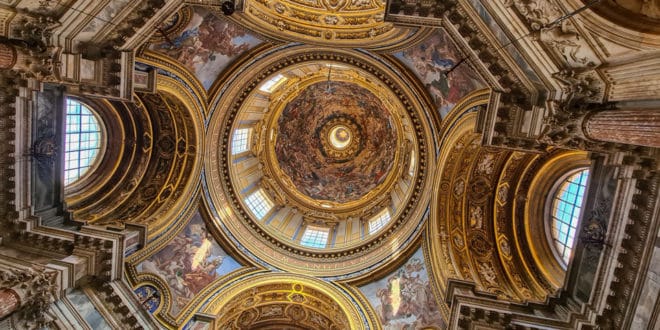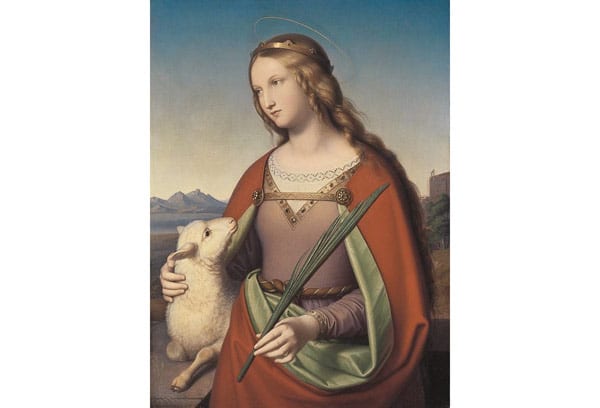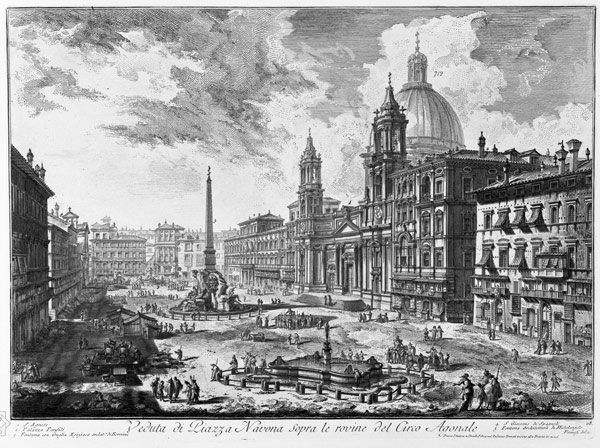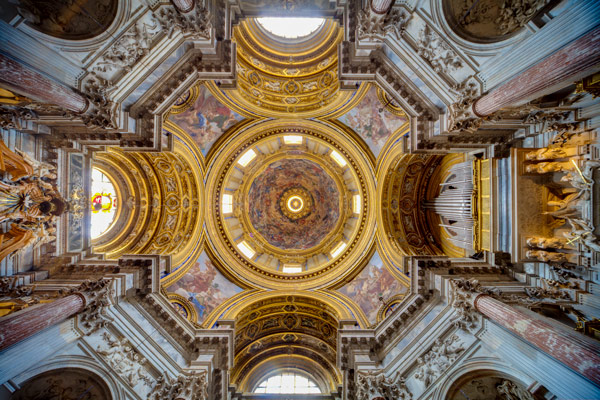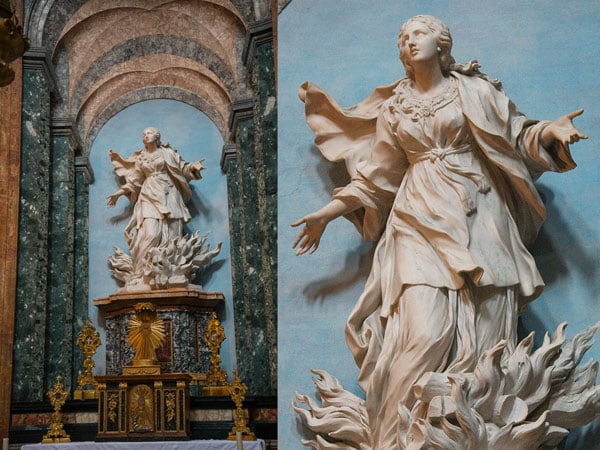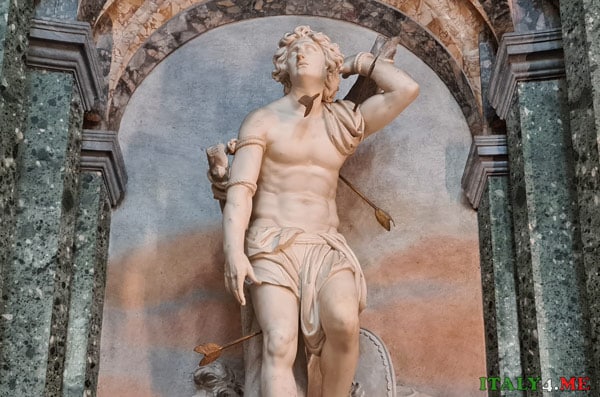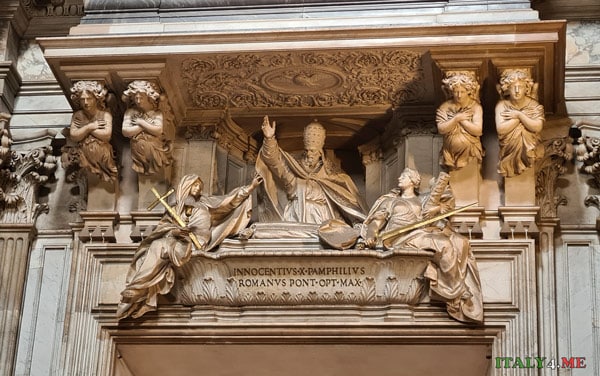The Church of Sant’Agnese in Agone on Piazza Navona is an outstanding architectural monument of Roman Baroque. This 17th-century Church stands on the remnants of an ancient structure, traditionally considered the site of the martyrdom of Saint Agnes of Rome (circa 291-304). The relics of the twelve-year-old girl (her skull), which have been venerated since the 7th century, are currently housed in one of the Church’s chapels.
The remarkable combination of the beauty of forms, the significance of the historical site, and the importance of the ancient sanctuary make this Church attractive to believers and connoisseurs of Italian art.
Page Contents
Name
Alongside its official name, the Church is also known as “Sant’Agnese al Circo Agonale,” “Sant’Agnese de Cryptis Agonis,” or “Sant’Agnese on Piazza Navona.” The addition of the word agone to the saint’s name signifies not the agony of the martyr but its relation to the historical site.
Site of Foundation
It is known that the famous square emerged on the site of an ancient Roman stadium, built in 86 AD by Emperor Domitian. The history of the Church is inseparably linked to this structure.
The Stadium of Domitian (Stadio di Domiziano), or Circus Agonalis, was constructed for the people of Rome, who demanded not only bread but also spectacles. Here, athletic contests were held, gathering around 20,000 spectators. The arena of the Greek type differed from the modern one – it had the shape of a horseshoe with the finish and start on the same southern side. The elongated Piazza Navona replicates the contours along the inner perimeter of the Stadium of Domitian, which today is 5 meters below the square’s level.
This structure gained its grim reputation from the brothels, public tortures, and executions that were commonplace in Ancient Rome. Around 304 AD, in one of the vaulted halls under the terraces of the stadium, Saint Agnes was humiliated, after which she was led by Roman soldiers into the arena and executed.
The official website of the Stadium of Domitian stadiodomiziano.com – there, you can check the current operating hours and ticket prices.
Please note: Opposite the entrance to the Church there is the famous fountain of 4 rivers.
Martyr Agnes
The story of the martyr Agnes (Agnes) has survived to this day only in legends. From them, you can put together a sad life story of a girl.
She was born into a Roman, non-poor Christian family. When the time came for marriage, after reaching 12 years of age, devout Agnes decided not to tie the knot and remain the bride of Christ. It was not just anyone who received a refusal, but Diocletian’s nephew. He could not stand the insult and decided to punish his bride.
The girl who chose devotion to her faith was sent to a brothel under the arches of the Stadium of Domitian. This method of punishment for women was known during the persecution of the first Christians under Emperor Diocletian. The captives, bound by their hands, were raped until complete exhaustion and death.
In the case of Agnes, a miracle happened – not a single man could take her virginity, as his strength left him. The next was an attempt to cover the girl with shame when she was presented to the crowd completely naked. To the surprise of everyone present, Agnes’s hair instantly grew back and hid her naked body.
On the day of the execution of a young Christian woman by burning at the stake in the arena of the Domitian Stadium, it rained and extinguished the fire, revealing another favorable attitude of God. The executioner was so enraged by this that he simply cut off his victim’s head
The Chapel and Early Church
Since Agnes came from a notable family, her body was not discarded but buried along with other executed Christians in the catacombs, over which the Church of Sant’Agnese fuori le mura (Church di Sant’Agnese fuori le mura) was built in 342 AD. Given the pilgrimage interest to the site of the virgin martyr’s execution, a chapel – a consecrated space for communal prayers – soon appeared in the vaulted spaces of the Stadium of Domitian. It is first mentioned in a surviving Roman guidebook from the 9th century, known as the Einsiedeln Itinerary.
The chapel, dedicated to Saint Agnes, was initially served by Byzantine rite Basilian monks and, from the 10th century, by the Benedictines of the Farfa Abbey (Abbazia di Santa Maria di Farfa).
The chapel’s conversion into a church was carried out under Pope Callixtus II, who consecrated it in 1123. In 1597, Sant’Agnese in Agone was transferred from the Benedictines to the Order of the Minim Regular Clerics (Chierici Regolari Minori), under whom the Church underwent a significant restoration. Piazza Navona already had several aristocratic palaces at this time, and the Church served as a burial place for their family members. Everything changed when a portion of the land on the square was purchased by the Pamphilj (Pamphili) – an ancient Italian family that left a notable mark on the history of Rome.
The Pamphilj
The aristocratic Pamphilj family, originally from Gubbio, moved to Rome at the end of the 15th century and gradually acquired the most influential positions in the Catholic Church and politics. The height of the Pamphilj’s power came during the pontificate of Innocent X, born Giovanni Battista Pamphilj, from 1644 to 1655.
The newly elected Pope consolidated his family’s position at the beginning of his reign. In 1646, in the heart of the Parione district, south of the Church of Sant’Agnese in Agone, construction began on the magnificent family palace – Palazzo Pamphilj. Then, the Pope conceived the idea of making the neighboring Church, dedicated to Saint Agnes, a family mausoleum. Having received a profitable offer from the Pamphilj, the Benedictine monks agreed to move to San Lorenzo in Lucina, and the parish was closed.
It’s recommended to read about Villa Doria Pamphili.
Design and Construction
The construction and finishing of the Church continued from 1652 to 1672, when it was consecrated.
The works began with the demolition of the old church building, except for the crypt, the ancient Roman remains of the Stadium of Domitian.
For the design of the new Church, Innocent X engaged his palace architect, Girolamo Rainaldi, and his son, Carlo Rainaldi, but their project still needs to be approved. In 1653, the Pope handed the commission over to Francesco Borromini. His architectural plan was more original, but the pontiff’s death in 1656 did not allow for the completion of the work. The new Pope, Alexander VII, who came to power, had many complaints about Borromini and ultimately dismissed the architect in 1657.
Innocent X’s nephew, Cardinal Camillo Francesco Maria Pamphili, returned Carlo Rainaldi to the works, who was soon replaced by Giovanni Lorenzo Bernini. The experienced and talented architect was invited by Olimpia Aldobrandini – the wife of the then-deceased cardinal.
The transition of the church project from the hands of Rome’s most famous architects ultimately in no way disrupted the overall style and magnificent view of Sant’Agnese in Agone.
It is commonly believed that the building plan belongs to Rainaldi, the Baroque facade belongs to Borromini, and the idea of the two symmetrical towers and interior belongs to Bernini.
The Architectural Plan of the Church
The architectural plan of Sant’Agnese in Agone is quite complex. It includes an octagon (a square within a circle) superimposed on a Greek cross, whose short sides are the transept, the top is the apse with the main altar, and the bottom end is the entrance from the side of Piazza Navona.
The octagonal dome with double ribs is on a high drum, adorned with Corinthian pilasters and rectangular windows. The Church is crowned with a cross on a globe, set on an elegant lantern by Girolamo Rainaldi.
The facade, designed by Borromini and completed by Rainaldi, has a concave shape characteristic of the Baroque style. Innovative for its time, it later became a prototype for many European buildings.
The main entrance with a large bronze door is framed by two pairs of Corinthian semi-columns, supporting an entablature with a sculpted architrave, blind frieze, and cornice with modillions. The triangular pediment with a flat tympanum is crowned by the coat of arms of Pope Innocent X, depicting a dove holding an olive branch in its beak – a symbol of the Pamphilj family’s peacefulness.
Giovanni Maria Baratta adds splendor to the facade with two three-story campaniles (bell towers).
Attention should be paid to the clocks placed on the plinth of the second-level facade. They showed time measured in different ways. Some were initially set to the ancient Roman method, where the dial was divided into 12 daytime hours, with 0:00 being sunrise and 12:00 being sunset. These clocks had to be constantly adjusted depending on the season, but at the wish of the Roman popes, they kept such a course until 1842. The other clocks immediately showed the “correct” time, known as tempo ultramontano, i.e., “time on the other side of the Alps.”
Artistic Decoration
The decor of Sant’Agnese in Agone is very luxurious, yet it lacks paintings by famous artists. For this reason, the Church was not even included in the 19th-century guidebook, which is unfair. The interior, abundant in rare colored marble, gilding, and rich stucco, features no less valuable 17th-century artworks: frescoes, magnificent relief panels, and sculptures.
Dome
Over the octagonal space of the interior dominates a dome of the empyrean model – one of the few existing in the churches of Rome.
The dome is created so that the viewer looking upwards feels a beautiful heavenly vault or empyrean — an infinite space inhabited by the souls of the blessed, contemplating God.
The stunningly beautiful fresco of the dome depicts the Apotheosis of Saint Agnes in Heavenly Glory. The painting was started by Ciro Ferri, and after he died in 1689, it was completed by Sebastiano Corbellini. The impression is intensified by the inscription on the frieze of the entablature at the bottom of the drum: “Agnes entered the place of shame and met the angel of the Lord waiting for her.”
The frescoes on the four pendentives of the dome are the first serious work of Giovanni Battista Gaulli, nicknamed Baciccio (Baciccia). The artist is often called “Bernini in paint” for his unique technique of conveying three-dimensional space in ceiling paintings. The frescoes depict the virtues of Prudence and Providence, Justice and Peace, Fortitude and Mercy, Temperance and Chastity. The figure with a pink crown in the last fresco is Lust. There were many speculations about which of the Pamphilj family’s female enemies this image resembles.
The lantern with a dove in the center of the dome symbolizes the Holy Spirit and a boastful hint at the dove of the Pamphilj coat of arms.
Chapels
The dome of the Church is supported by four massive pillars, each containing a small apsidal chapel framed by columns of red cottoanello marble. The four altars are dedicated to Saints Alexius, Emerentiana, Eustace, and Cecilia. The marble altarpiece reliefs devoted to the martyrs are sculptural masterpieces of the Baroque, created by renowned masters Giovanni Francesco Rossi, Ercole Ferrata, Melchiorre Cafà, and Antonio Raggi. The stucco decorations and angels in the half-domes of the niches of these chapels were executed and donated to the Church by Ferrata’s workshop.
The chapels at opposite ends of the transept are identically decorated with yellow alabaster, red and polychrome marble, breccia, and rich gold stucco. The illusionistic space of the chapels is created by a recessed oval niche and a blue background.
The Chapel of Saint Agnes (Cappella di S. Agnese) at the right end of the transept is located closer to the site of her martyrdom. It is adorned with a magnificent sculpture by Ercole Ferrata, created in 1660 from a design by Bernini. The Immaculate Agnes is depicted in symbolic flames, representing the fire of sexual temptation.
The sculpture in the chapel opposite (Cappella di S. Sebastiano) – Saint Sebastian pierced by arrows, is the work of Pietro Paolo Campi, 1719.
Traditionally, this Christian martyr is depicted as a beautiful young man who accepted death gracefully. Incidentally, homosexuals consider Saint Sebastian their patron saint. Two marble angels hovering over Sebastian were made by Pierre Le Gros, Pietro Paolo Campi’s teacher.
To the right of the Chapel of Saint Sebastian is the Chapel of Saint Philip Neri (Cappella di San Filippo Neri), with a beautiful ceiling fresco by Francesco Allegrini. Inside the shrine, in the form of a miniature temple, is the Church’s main relic – the skull of Saint Agnes. It was moved to this location in 1908 by order of Pope Pius X. Before that, the relic was part of the collection of relics of the Papal Chapel of Saints’ relics in Rome “Sancta Sanctorum” (Chiesa di San Lorenzo in Palatio ad Sancta Sanctorum). The small-sized skull truly belongs to a child and looks touching in the richly decorated chapel.
One of the chapels is dedicated to Saint Francesca Romana, who was baptized here within the walls of the old Church. As a sacred relic, the baptismal font of those times is kept under the chapel’s altar. The authorship of the marble bas-relief and the poorly preserved ceiling fresco must be precisely established.
Main Altar
The main altar of the Church is dedicated not to its patroness, as was originally intended, but to John the Baptist. The white marble bas-relief, created in 1688 by Domenico Guidi, depicts the Holy Family with the infant John and his parents, Elizabeth and Zechariah. The current altar was erected in 1724 based on a design by Carlo Rainaldi, later realized by Ciro Ferri. Of interest are the four fluted columns of green marble, which could have been taken from the demolished triumphal arch of Marcus Aurelius (2nd century AD).
Borromini’s Sacristy
The door in the left part of the Chapel of Saint Agnes leads to the sacristy. It can also be accessed through a separate entrance from Via del Anima. This so-called summer sacristy, having the structure of a separate church, was used for the Pamphilj family’s private functions. It was built between 1658 and 1666, according to a project by Francesco Borromini. The octagonal hall is richly decorated with paintings and gilded stucco.
Along the side walls are wooden choirs, indicating that meetings of the College of Priests were initially planned to be held here.
The cylindrical vault, painted by Francesco Allegrini, shows stories from the life of the Virgin Mary. The altar icon and the frescoes on the apse walls are also dedicated to the Mother of God. The sacristy houses a 17th-century painting, “The Glorification of Saint Agnes,” by Paolo Gismondi, known as Paolo Perugino.
The compact Borromini Sacristy has remarkable acoustics, a discovery for holding chamber music concerts from the Italian Baroque era.
The Crypt of Saint Agnes
The oldest part of Sant’Agnese in Agone is the Crypt of Saint Agnes.
It consists of three rooms from the ancient Roman Stadium of Domitian. One of them was a brothel, and it was here that Saint Agnes was subjected to insults. The last room is an ancient chapel from which the Church originated. The crypt’s rooms constantly suffered from dampness, as they were often flooded. This continued until 1866 when the Pamphilj family organized the traditional festival and transformed Piazza Navona into a lake where Romans would row boats.
The crypt’s frescoes, dating back to the 17th century, were damaged by moisture but are still interesting. The marble bas-relief by Giovanni Buratti, depicting Saint Agnes, makes a strong impression. It captures a very realistic scene at the moment when Roman soldiers are leading a twelve-year-old girl to her execution.
The Pamphilj family owned Sant’Agnese in Agone for over 300 years and only in 1992 donated it to the Roman diocese. Much of the Church recalls the famous family. Here lies the family crypt, the burial of the remains of Innocent X (in the Chapel of Saint Francesca Romana) and his tombstone, created in 1729 by Giovanni Battista Maini, coats of arms, and recognizable doves with a palm branch in their beak.
Opening Hours
The Church is open to visitors daily, except for Monday, from 9 am to 12:30 pm and 3:30 pm to 7:00 pm. On holidays, the opening hours may change. Entrance is free.
The architectural splendor of the Church of Saint Agnes at Piazza Navona is complemented by a rich spiritual life. Concerts are held within its walls, art exhibitions are organized, and book presentations occur.
 Italy for me From Italy with love
Italy for me From Italy with love

